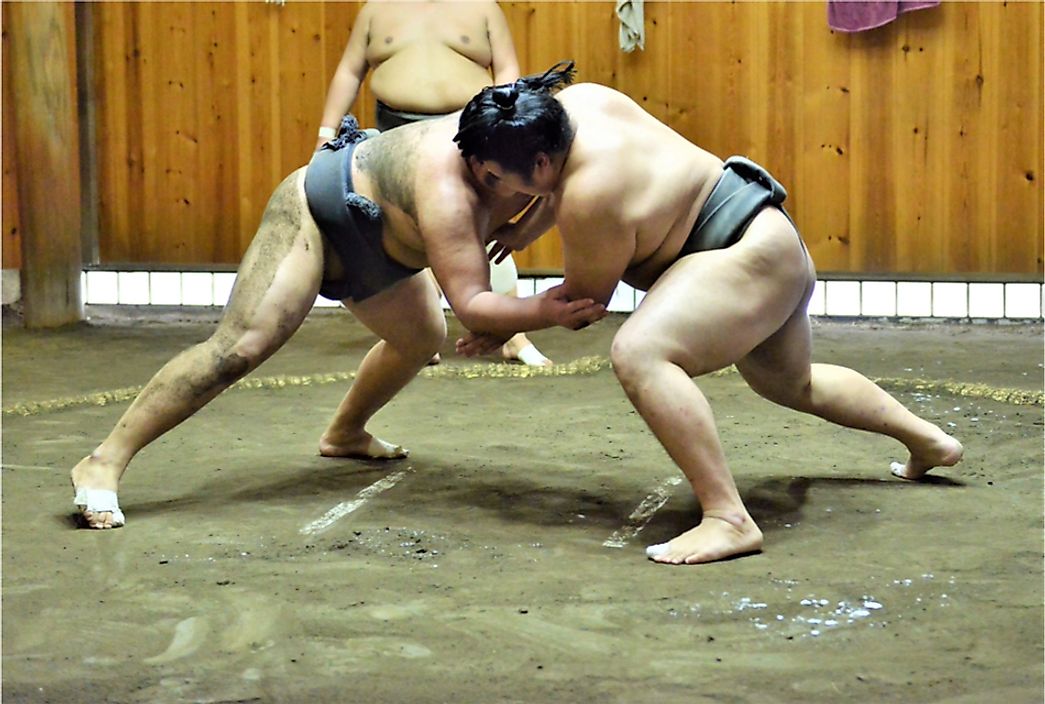What Is Sumo?

Sumo is a competitive full body contact wrestling match in which a wrestler (rikishi) tries to push his opponent out of the circular ring (dohyo) or force him to the ground. Sumo wrestling originated in Japan, and it is practiced professionally only in Japan. Sumo has been practiced in Japan for centuries, and most traditions of the game, like using salt purification, are still used. Sumo wrestlers live in a shared training stable (heya), where most aspects of their lives, like dressing and meals, are dictated by the strict sumo tradition.
The Origin of Sumo
Sumo is associated with rituals of the Shinto religion. In fact, some shrines perform a ritual dance similar to a sumo match, in which a human wrestles a divine spirit. The Shinto ritual was crucial for the imperial courts centuries ago, and every province was required to take part in the contest, known as sumai-no-sechie. The popularity of sumo changed depending on the rulers, and during periods of civil conflict the Japanese used sumo as a practicing tool. Over time the Japanese adopted the concept of winning the match by pushing your opponent out of the ring, rather than simply throw an opponent.
The idea of using a circular ring instead of the space left by the spectators came into being in the 16th century during a tournament organized by Oda Nobunaga. During the 16th century, wrestlers wore loose loincloths, and during the Edo period they wore decorative fringed aprons (kesho-mawashi). Professional sumo wrestling began during the Edo era as a unique type of entertainment, and the first professionals were samurai. Modern style tournaments started in 1684 in the Tomioka Hachiman Shrine. Western parts of Japan also held competitions in Osaka. However, Osaka sumo ended in 1926 when it merged with Tokyo to form one sumo organization.
Rules of a Sumo Match
The winner of a sumo match must force his opponent out of the ring or to the ground. A wrestler can also lose the match if he uses an illegal technique, if his belt (mawashi) is undone, or if he fails to show up. Sumo matches have a single round which often last for only a few seconds, but in some rare instances they can last for minutes. Sumo does not have weight divisions, and an elaborate ritual is always performed before a match starts. After the match ends, an off-stage referee determines the winning technique, and then announce the winner to the spectators.
In rare instances, the wrestle that touched the ground first can be declared the winner. This only occurs in instance in which both wrestlers fell at almost the same time. In this scenario, the referee argues that the second wrestler to touch the ground could not have won since his opponent had him in an irrecoverable pose. In these instances, the losing wrestler is called "shini-tai," which means "dead body."
Size of the Wrestling Ring
Matches take place in a circular ring with an area of 175 sqft and a diameter of 14.9 ft. The platform is usually made up of a mixture of clay and sand, with rice-straw bales placed on top. The ring has two white lines in the middle, where the wrestlers position themselves at the start of the match. A new ring is built for every tournament.











